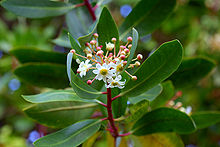Winter's Bark
| Drimys winteri | |
|---|---|
 |
|
| D. winterii flowers | |
| Scientific classification | |
| Kingdom: | Plantae |
| Clade: | Angiosperms |
| Clade: | Magnoliids |
| Order: | Canellales |
| Family: | Winteraceae |
| Genus: | Drimys |
| Species: | D. winteri |
| Binomial name | |
|
Drimys winteri J.R. Forst. & G. Forst. |
|
Drimys winteri (winter's bark or canelo) is a slender tree, growing up to 20 m (66 ft) tall. It is native to the Magellanic and Valdivian temperate rain forests of Chile and Argentina, where it is a dominant tree in the coastal evergreen forests. It is found below 1,200 m (3,937 ft) between latitude 32° south and Cape Horn at latitude 56°. In its southernmost natural range it can tolerate temperatures down to −20 °C (−4 °F).
The leaves are lanceolate, glossy green above, whitish below and can measure up to 20 cm (8 in). The flowers are white with a yellow center, and consist of a great number of petals and stamens. The fruit is a bluish berry.
When Sir Francis Drake sailed round the world in 1577-80, of the four ships accompanying the Golden Hind at the outset, the only ship that successfully rounded Cape Horn with him was the Elizabeth, captained by John Wynter; the two ships separated in a storm and Winter turned back. Presumably he had sickness on board, for he sent a boat ashore to search out medicinal herbs. He returned in 1579 with a supply of Drimys bark, and for centuries before vitamin C was isolated, "Winter's Bark" was esteemed as a preventive and remedy for scurvy— correctly so, for an infusion of D. winteri sustained Captain James Cook and his crew in the South Pacific, and the naturalist accompanying his voyage of exploration, Johann Reinhold Forster, was the first to officially describe and name D. winteri.
...
Wikipedia
